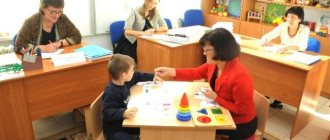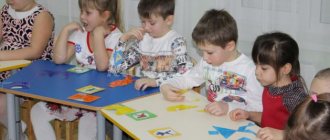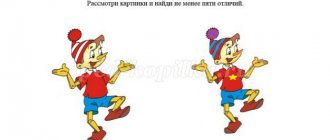Psychological characteristics of senior preschool age
Preschool childhood is a very unique period of human development. The period boundaries are from three to seven years. This long period is divided into two stages. The first is the stage of junior preschool age (from 3 to 5 years), and the second is the stage of senior preschool age (from 5 to 7 years).
At this age, the child’s entire mental life and his attitude to the world around him are restructured. The essence of this restructuring is that in preschool age the inner life of the soul and internal behavioral regulation are formed.
In preschool age, under the influence of training and upbringing, intensive development of all cognitive mental processes occurs.
Memory. Preschool age is the most favorable age for memory development. Memory becomes the dominant function. The child easily remembers a variety of materials.
Memory development moves from involuntary and direct to voluntary and mediated recall and reminder. In middle preschool age (4 to 5 years), voluntary memory begins to form.
Memory, which is more and more connected with speech and thought, becomes intellectual, elements of verbal-logical memory are formed.
Think. Thinking in preschool age is characterized by a transition from visual-actual to visual-imaginative and at the end of the period to verbal thinking. However, the main type of thinking is visual-imaginative. A preschooler thinks figuratively, but has not yet mastered the logic of thinking of an adult. He/she solves mental problems in the representation and his/her thinking becomes extra-situational. Conditions are created for such mental qualities as independence, flexibility and curiosity. There are attempts to explain phenomena and processes. Children's questions are indicators of the development of curiosity.
Address. At the age of seven, language becomes a means of communication and thinking for a child, as well as an object of conscious learning, since learning to read and write begins in the process of preparing for school. According to psychologists, the language really becomes native to the child.
The phonetic side of the language is developing. Younger preschoolers learn about the idiosyncrasies of their pronunciation. By the end of preschool age, the process of phoneme development is complete. The child's vocabulary is growing rapidly. The grammatical structure of the language develops. Children learn the subtlest patterns of morphological order (word structure) and syntax (sentence structure). The child learns grammatical forms of speech and actively expands his vocabulary, which allows him to move on to contextual speech at the end of preschool. He can retell a story or fairy tale he has read, describe a picture, convey his impressions of what he saw.
Perception. Perception in preschool age loses its original affective character: perception and emotional processes differ. Perception becomes meaningful, focused and analytical. It prescribes voluntary actions - observation, consideration, search. Language has a significant influence on the development of perception at this time - the child begins to actively use the names of qualities, characteristics, states of various objects and relationships between them.
Attention, its types, functions and properties
Attention is attention. This is connected with the interests and talents of the child; his properties depend on such qualities: Observation, the ability to notice subtle but significant features in objects and phenomena. Attention is one of the main conditions for successful reception
availability for him of the volume of knowledge, skills and establishing contact with adults. In the absence of attention, a child cannot learn to imitate the actions of an adult, nor act according to a model, nor follow verbal instructions. The development of attention is closely intertwined with the development of memory.
The preschooler's attention reflects his interests in relation to surrounding objects and actions performed with them. The child focuses on an object or action only until his interest in that object or action wanes. The appearance of a new subject causes a shift in attention, so that children rarely engage in the same activity for a long time.
The main types of attention are: natural and socially conditioned attention, direct and indirect attention, sensory and intellectual attention, involuntary, voluntary and post-procedural attention.
Natural attention is paid to a person from birth as an innate ability to selectively respond to specific external or internal stimuli that carry elements of information novelty. The basic mechanism that allows this attention to function is called the orienting reflex. Socially conditioned attention is formed throughout life through training and education and is associated with the volitional regulation of behavior, with a selective conscious reaction to objects.
Direct attention is not controlled by anything other than the object to which it is directed and which corresponds to the actual interests and needs of the person. Indirect attention is controlled by specific means, for example, gestures, words, prompts, objects.
Sensory attention is associated with emotions and the selective work of the senses, intellectual attention is associated with concentration and direction of thoughts. With sensory attention, the sensory impression is at the center of consciousness, and with intellectual attention, the object of interest is thought.
Voluntary (intentional) attention is attention that is consciously directed and regulated. This is associated with volitional efforts and, as a rule, depends on the specific goal set.
Development of voluntary attention of preschoolers in play activities
Author: Glazova Yana Alekseevna
Article: Glazova Y.A. Development of voluntary attention of preschool children in play activities
The problem of attention is considered one of the most important and complex problems in psychology. The development of the entire system of psychological knowledge, both fundamental and applied, depends on its solution.
The significance of attention in human life, its determining role in the selection of the contents of conscious experience, memorization and learning are obvious. It is also difficult to doubt the need for a comprehensive and detailed study of its phenomena.
In contrast to such cognitive processes as thinking, memory, perception, attention does not have its own special content; it appears, as it were, within these processes and is inseparable from them. Attention characterizes the dynamics of mental processes. Thus, this mental process is a condition for the successful implementation of any activity, both external and internal, and its product is its high-quality implementation. The main condition for the development of voluntary attention in preschool children can be play as the child’s main activity. In preschool age, play is of utmost importance in the life of a small child: play for them is study, play for them is work, play for them is a serious form of education. The game accustoms him to observation, to following certain rules, and disciplines his will. Play for preschoolers is a way of learning about the world around them. In the game, the child acquires new knowledge, skills and abilities.
Voluntary attention is one of the most important characteristics of children’s cognitive activity. Along with thinking, perception, memory, and imagination, voluntary attention is the most important acquisition of personality at this stage of ontogenesis. It is associated with the formation of volitional qualities in the child and is in close interaction with the general mental development of the child.
There are several approaches to understanding voluntariness. The first of them distinguishes between voluntary and volitional actions. Volitional actions, according to researchers of the first approach (G.S. Kostyuk, V.I. Asnin), “occur in a situation of restructuring stereotypes, in the presence of difficulties.”
Voluntary behavior, the authors believe, can be formed through the targeted development of the volitional sphere. These researchers understand by will the aspirations, desires, goals, decisions of a person, his conscious, purposeful actions, actions, his perseverance, determination, endurance and other qualities. Will is one of the ways of conscious regulation of activity and behavior, the ability acquired by a person to consciously set goals, make decisions and subordinate his actions and actions to them.
The third point of view on the mechanism of occurrence of voluntary behavior belongs to A.R. Luria and A.V. Zaporozhets. Researchers believe that preschoolers subordinate their behavior not to words, but to situational circumstances. Those. In order for the child to be guided in his actions by verbal instructions, it is necessary to create special conditions.
The formation of arbitrariness of behavior in preschool age goes from the “pre-situational” freedom of children to the appearance of barriers and effort, and then, in older preschool age, to the acquisition of “above-situational” freedom. These data suggest that the psychological mechanism for the development of voluntariness, and in particular voluntary attention, is the gradual “volition” of behavior, the consistent penetration of will into children’s behavior, leading through the child’s use of effort to gain freedom in action.
Involuntary attention reaches a high level of development in preschool age. The emergence of new interests and participation in new activities force the child to focus on aspects of reality that previously went unnoticed.
The preschooler's attention span and ability to engage in a particular task or subject for a long time increases. Preschoolers can spend hours playing some interesting game, drawing or designing.
The organization of educational work is of decisive importance in the development of involuntary attention. By introducing the preschooler to the surrounding reality, encouraging him to actively display this reality in his games, activities, and visual arts, the teacher arouses interest in new objects and phenomena, forcing the child to involuntarily focus his attention on them.
If involuntary attention reaches a high stage of development in preschool children, then voluntary attention is just beginning to form in them.
Carrying out instructions from adults, carrying out some responsibilities in kindergarten and at home, taking part in group games, a preschooler is increasingly faced with conditions where he has to pay attention to what is necessary to carry out the intended task, which corresponds to the verbal instructions of an adult or the requirements of the children's group. . Thus, new living conditions, specially organized by parents and educators, lead to the formation of voluntary attention.
F. Schiller believed that “play arose for pleasure... Only by playing can one become a person.” Thorndike stated: “Play is an hereditary instinct.” Bucher: “Game is a form of excess energy.” Kant: “Play is a disinterested activity... An activity in itself.”
The Swiss scientist K. Gross considered games to be the original school of behavior [39, 106]. For him, no matter what external or internal factors motivate the games, their meaning is precisely to become a school of life for children. This approach is simple and wise. The game is objectively a primary spontaneous school, the apparent chaos of which provides the child with the opportunity to become familiar with the traditions of behavior of the people around him. Nature, as it were, specially provided higher animals and humans with a long period of childhood, so that, while playing, they developed vital organs and functions.
The founder of psychoanalysis 3. Freud developed the idea of the compensatory nature of play, connecting it with the unconscious mechanisms of the psyche. The first function of the game, according to Freud, is the symbolic realization of unconscious drives, which provides cleansing and healing of the psyche. The second function of the game is related to the fact that traumatic situations, which are the source of neurosis, are resolved and removed.
In modern languages, the concept of game is also extremely polysemantic. The prominent game theorist Huizinga defines this concept with the following formula: “Game is a voluntary action or activity performed within established boundaries of place and time according to voluntarily accepted but absolutely obligatory rules with a purpose contained in itself, accompanied by a feeling of tension and joy, as well as consciousness “another existence” than “everyday life” [68,10]. Huizinga's ideas have not lost their relevance. The scientist, with his book “Man Playing,” proves that human creativity is a moment of play as a moment of truth. Considering play action in different historical layers, Huizenga comes to the most important generalizations: play is a necessary way of social life, the objective basis of our existence].
The brilliant researcher of the game D.B. Elkonin believes that the game organizes activity with the help of cult symbols and, therefore, teaches one to navigate cultural phenomena and helps to use them appropriately. Special studies have established that the first needs of a child are social. D.B. Elkonin writes: “The world of a child is, first of all, an adult as the most important part of the reality surrounding the child, part of the world of adults.” This means that the game is social in nature and immediate saturation and is projected to reflect the world of adults.
Through play, a child enters the world of adults, masters spiritual values, and assimilates previous social experience. We can consider that in the game the child receives for the first time a lesson in collective thinking. This circumstance is of fundamental importance if we take into account that the child’s future is connected with socially useful work, the most important quality of which is the joint, collective solution of problems aimed at achieving a common goal.
So, the game performs essential functions in the formation of the child’s personality. It reflects and develops the knowledge and skills acquired in classes at preschool educational institutions, and establishes the rules of behavior that children are taught to follow in life. Play acts as the main leading type of children's activity and as the most important condition for social education. The game develops the mental abilities necessary for every child, the level of development of which, of course, affects the process of schooling. That is why it is necessary to pay special attention to the play activities of older preschoolers.
When we talk about play as the leading activity of a preschooler, we mainly mean joint role-playing play. Other types of games - outdoor, didactic, construction - although widely used in preschool education, serve to implement private educational tasks.
To develop voluntary attention, it is necessary to arouse in the child emotional interest in his activities, which becomes possible when using, first of all, the leading activity of a preschooler - games. It is still difficult for children to concentrate on monotonous and unattractive activities, while in the process of emotionally charged play they can remain attentive for quite a long time.
In the game, the basic elements of volitional action are formed: the child sets a goal, makes a decision, outlines a plan of action, executes it, shows a certain effort in overcoming obstacles, and evaluates the result of his action.
Voluntary regulation of behavior consists in subordinating the child’s behavior to the task, that is, in his ability to concentrate on what the adult suggested, on attempts to actively solve the problem, on overcoming everything that is not related to the main activity. Arbitrariness, in turn, provides a sufficient level of gaming motivation.
Insufficient voluntary attention - the child finds it difficult to concentrate attention on demand.
Such deficiencies cannot be eliminated by fragmentary “attention exercises” included in the process of working with a child and require specially organized work to overcome them.
The main change in attention in preschool age is that children aged 6-7 years first begin to manage their attention, consciously direct it to certain objects, phenomena, and stay on them, using certain means for this, i.e. so-called voluntary attention arises.
Age-related features of the development of voluntary attention in older preschoolers are the comparative weakness of voluntary attention and its low stability. Children do not yet know how to concentrate on a task for a long time, especially if it is uninteresting and monotonous; their attention is easily distracted. The possibilities of volitional regulation of attention and its management in older preschool age are very limited. Educators and parents are faced with the most difficult task - to think through the special work of organizing children’s attention, otherwise it will be at the mercy of surrounding things and random coincidences.
The development of voluntary attention is the most important task of preschool education. In the future, it will ensure the child’s success in school, help him follow the teacher’s instructions and control himself.
Voluntary attention is formed due to the fact that adults include the child in new activities such as games according to the rules, construction, etc., and with the help of certain means they direct and organize his attention. When introducing the child to these types of activities, adults organize his attention using verbal instructions. The child is directed to the need to perform given actions, taking into account certain circumstances.
One of the main means of developing voluntary attention is play, which acts as the main leading type of children's activity and as the most important condition for public education. A special role in the formation of voluntary attention is played by games with rules, which, in addition to increasing the level of development of the basic qualities of voluntary attention, contribute to the education in children of strong-willed character traits, activity, independence and determination.
Sources:
Barmashova E. Game mosaic: a program of classes for developing attention in preschool children [Text] / Elena Barmashova // School psychologist. - 2005. - No. 5. - P. 8-14.
Baskakova I.L. Attention of a preschooler, methods of its study and development. Studying the attention of schoolchildren [Text] / I.L. Baskakova. - M.: Publishing house "Institute of Practical Psychology", Voronezh-NPO "MODEK", 1995. - 64 p.
Preschooler's game [Text] / L.A.
Abrahamyan, T.V. Antonova, L.V. Artemova and others; Ed. S.L. Novoselova.— M.: Prosveshchenie, 1989.— 286 p.: ill.— (Book of a kindergarten teacher). Attached files: comments powered by HyperComments
Characteristics of voluntary attention
The basis of voluntary attention is the control of the intended goal. This type of attention is unthinkable without a certain effort of will on the part of the individual and its formation in the process of activity. This gave rise to the second name - voluntary attention (active, intentional).
When a person decides to engage in a certain type of activity, he realizes this intention by consciously directing his attention to something that may not interest him. However, to achieve this goal it is necessary to participate in it. The main function of volitional attention is the highly active direction of the course of psychological processes.
Accordingly, the determinants of voluntary attention are not biological, but social indicators. This type of attention is not formed in the child’s body, but develops in the process of interaction with adults. Despite the obvious differences from involuntary attention, voluntary attention is impossible without emotions, interests and life experience.
Regardless of the difference between voluntary and involuntary attention, they do not need to be separated and opposed. Involuntary attention develops from involuntary attention, and one cannot simply develop voluntary attention. The basis of its formation includes the following components:
- Interests,
- child's wishes,
- hobby.
The guiding function of voluntary attention is represented by the active regulation of the course of mental processes. Researchers have focused on the phenomenon of voluntary attention as an activity aimed at regulating behavior and maintaining stable selective activity.
Content
- What are the types of attention?
- Why does a child have reduced attention?
- How to develop attention skills in a child
- Schulte tables
- Stroop test
- Camera
- Exercises with objects
- Labyrinths
- Fly
- Find the differences
- Snowball
- Reverse Day
Attention is a focus on objects and phenomena that are most important at a particular moment.
The cognitive process is impossible without the ability to focus and concentrate attention. It is especially important for children to fully engage in the learning process, the content of the lesson and the teacher’s speech, so that the work is effective and brings excellent results both in school and outside the classroom. Many parents say that their child has a bad memory, but they don’t even suspect that it’s actually attention that’s lacking. These basic mental functions are inextricably linked. There can be no good memory without trained attention.
Features of voluntary attention
For preschool age, the most important thing is purposefulness of attention. It is determined by the tasks that a person begins to set for himself in a particular activity. This is also the organized nature of the activity, when a preschooler expresses a desire to pay attention to a specific subject.
The child consciously sets goals and activates the mental processes necessary to achieve them. He begins to maintain his attention over a long period of time and defines activities by tasks or plan through which he expresses his intentions.
Reasons determining voluntary attention:
- The interests of the child that motivate him to participate in this activity;
- The concept of duty and obligation, which claims the need to perform a certain type of activity as efficiently as possible;
- Formation of voluntary attention, reflecting the orientation of the interests of the individual and denoting his personal and volitional qualities.
Already A.A. Ukhtomsky wrote that involuntary attention is “managed” (managed) by objects in the external world, and the “master” of voluntary attention is the personality of an adult or child.






